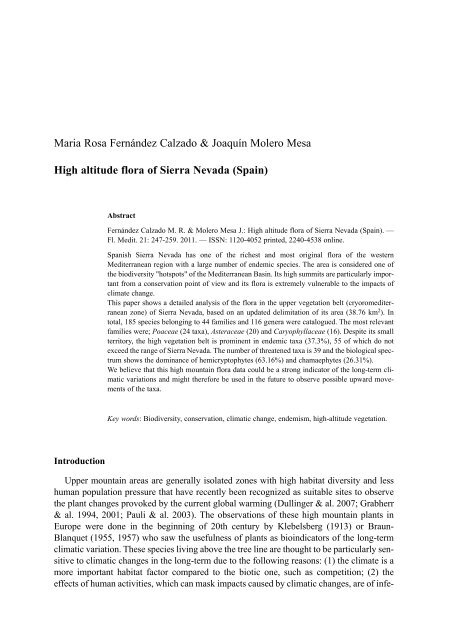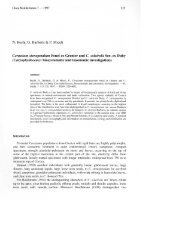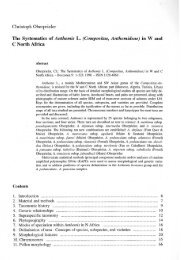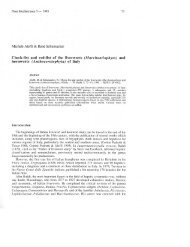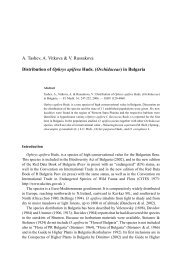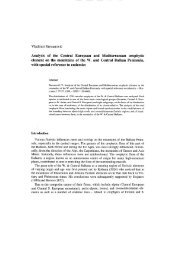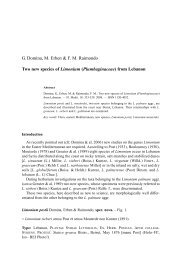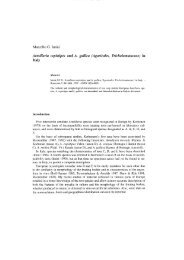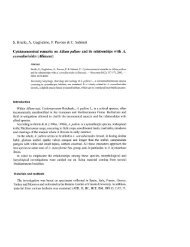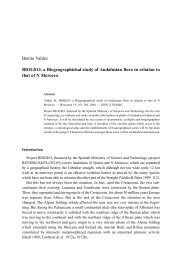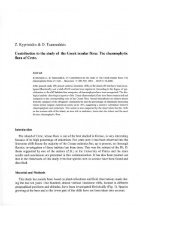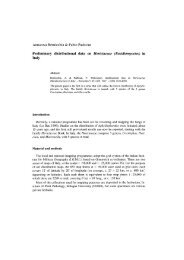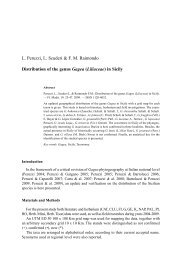Maria Rosa Fernández Calzado & Joaquín Molero ... - Herbmedit.org
Maria Rosa Fernández Calzado & Joaquín Molero ... - Herbmedit.org
Maria Rosa Fernández Calzado & Joaquín Molero ... - Herbmedit.org
Create successful ePaper yourself
Turn your PDF publications into a flip-book with our unique Google optimized e-Paper software.
<strong>Maria</strong> <strong>Rosa</strong> <strong>Fernández</strong> <strong>Calzado</strong> & <strong>Joaquín</strong> <strong>Molero</strong> Mesa<br />
High altitude flora of Sierra Nevada (Spain)<br />
Introduction<br />
Abstract<br />
<strong>Fernández</strong> <strong>Calzado</strong> M. R. & <strong>Molero</strong> Mesa J.: High altitude flora of Sierra Nevada (Spain). —<br />
Fl. Medit. 21: 247-259. 2011. — ISSN: 1120-4052 printed, 2240-4538 online.<br />
Spanish Sierra Nevada has one of the richest and most original flora of the western<br />
Mediterranean region with a large number of endemic species. The area is considered one of<br />
the biodiversity "hotspots" of the Mediterranean Basin. Its high summits are particularly important<br />
from a conservation point of view and its flora is extremely vulnerable to the impacts of<br />
climate change.<br />
This paper shows a detailed analysis of the flora in the upper vegetation belt (cryoromediterranean<br />
zone) of Sierra Nevada, based on an updated delimitation of its area (38.76 km 2 ). In<br />
total, 185 species belonging to 44 families and 116 genera were catalogued. The most relevant<br />
families were; Poaceae (24 taxa), Asteraceae (20) and Caryophyllaceae (16). Despite its small<br />
territory, the high vegetation belt is prominent in endemic taxa (37.3%), 55 of which do not<br />
exceed the range of Sierra Nevada. The number of threatened taxa is 39 and the biological spectrum<br />
shows the dominance of hemicryptophytes (63.16%) and chamaephytes (26.31%).<br />
We believe that this high mountain flora data could be a strong indicator of the long-term climatic<br />
variations and might therefore be used in the future to observe possible upward movements<br />
of the taxa.<br />
Key words: Biodiversity, conservation, climatic change, endemism, high-altitude vegetation.<br />
Upper mountain areas are generally isolated zones with high habitat diversity and less<br />
human population pressure that have recently been recognized as suitable sites to observe<br />
the plant changes provoked by the current global warming (Dullinger & al. 2007; Grabherr<br />
& al. 1994, 2001; Pauli & al. 2003). The observations of these high mountain plants in<br />
Europe were done in the beginning of 20th century by Klebelsberg (1913) or Braun-<br />
Blanquet (1955, 1957) who saw the usefulness of plants as bioindicators of the long-term<br />
climatic variation. These species living above the tree line are thought to be particularly sensitive<br />
to climatic changes in the long-term due to the following reasons: (1) the climate is a<br />
more important habitat factor compared to the biotic one, such as competition; (2) the<br />
effects of human activities, which can mask impacts caused by climatic changes, are of infe-
248 <strong>Fernández</strong> <strong>Calzado</strong> & <strong>Molero</strong> Mesa: High altitude flora of Sierra Nevada (Spain)<br />
rior relevance, compared to lowland regions; (3) the majority of vascular plants are slowgrowing<br />
and long-lived perennials, thus, are expected to indicate impacts of a continued climate<br />
change rather than effects of short-term climate oscillations (Pauli & al. 1999).<br />
Nowadays, the consequences of climatic change on mountain plants have already been<br />
recognised: upward range expansions, increase on species richness, extinctions, etc<br />
(Erschbamer & al., 2009; Grabherr & al., 1994, 2010; Holzinger & al., 2008; Klanderud<br />
& Birks, 2003; Vittoz & al., 2008). Therefore, in order to protect the flora, it is important<br />
to know in detail its current situation in the mountain areas which might be threatened by<br />
the effects of global warming. This is the case of Sierra Nevada (southern Spain), an outstanding<br />
massif in the Mediterranean region detected as a vulnerable biodiversity hotspot<br />
in the Mediterranean basin (<strong>Fernández</strong>-González & al. 2005; Médail & Quézel 1997,<br />
1999). The importance of the massif, characterised by an exceptional concentration of<br />
endemic taxa on its higher summits (Blanca & <strong>Molero</strong> Mesa 1990; Blanca & al. 1998;<br />
Rivas-Martínez & al. 1991), is well documented in the context of national and international<br />
biodiversity (Blanca 1996; <strong>Molero</strong> Mesa & Pérez Raya 1987; <strong>Molero</strong> Mesa & al.<br />
1996; Myers 2000; Quézel 1953; Rivas Goday & Mayor López 1966). The current projections<br />
on changes in temperatures and precipitation conditions on the Iberian Peninsula,<br />
where Sierra Nevada is located, threaten its flora and endanger its biodiversity (<strong>Fernández</strong>-<br />
González & al. 2005). Therefore, we consider this study to be a very useful research as it<br />
contributes to a current and detailed analysis about the highest mountain flora of Sierra<br />
Nevada, information that could be used in the future as a testimony for variations that<br />
might be provoked by climatic change.<br />
Methods<br />
Study area.- The Sierra Nevada massif is part of the Baetic Cordillera in the southern<br />
part of Spain and stretches over about 90 km in west-east direction (Fig. 1). Its altitude<br />
exceeds the rest of Baetic Cordillera by 1100 m, with numerous summits above 3000 m<br />
a.s.l., including the highest peak on the Iberian Peninsula (Mulhacen, 3481m).<br />
The study area coincides with the limits of the upper vegetation belt, called the cryoromediterranean<br />
belt by Rivas-Martínez (1981, 2007). This area only covers 38,8 km 2<br />
with its lower boundaries oscillating between 2750 m, on northern and western slopes and<br />
3290 m on southern and eastern (<strong>Fernández</strong> <strong>Calzado</strong> 2007; <strong>Molero</strong> Mesa & al. 2009). The<br />
limit of the lower vegetation belt, oromediterranean, is approximately between 1900-2200<br />
m (Valle & al. 2003).<br />
Its bedrock composition consists mainly of highly weathered feldspar and graphitic<br />
mica schist (Gómez Ortiz & al. 2009). The landscape includes steep slopes, scree and<br />
rocky areas that were partly shaped by Pleistocene glaciers.<br />
Biogeographically speaking, the area belongs to the Nevadense sector of the Baetic<br />
province of the Mediterranean region (Rivas-Martínez 2007). Unlike elsewhere in Europe,<br />
several species of the study area are shared with the High Atlas range (Morocco).<br />
From a bioclimatic point of view, Sierra Nevada is exposed to a Mediterranean bioclimate<br />
in its pluviseasonal oceanic variant (Rivas-Martínez 2007). There is a pronounced summer<br />
drought at all altitudes and above 2500 m precipitation falls almost exclusively as snow.
Flora Mediterranea 21 — 2011 249<br />
Fig. 1. Location of the study area.<br />
Data sources.- The background of this work is the international monitoring programme<br />
GLORIA (Global Observation Research Initiative in Alpine Environments;<br />
www.gloria.ac.at), a network with more than 70 research teams distributed over five continents<br />
which have been developed during the last decade in order to establish and maintain<br />
standardised long-term observation sites for climate change impacts on alpine biota.<br />
Specifically in the upper zone of Sierra Nevada eight monitoring summits have been<br />
installed (Pauli & al. 2004; <strong>Molero</strong> Mesa & al. 2009) in the year 2000.<br />
Then, the cited project was the point of departure for a wider and more detailed study<br />
about the highest mountain flora on the massif, with the intention to asses its richness and<br />
biodiversity. The floristic data is based on the field work carried out over 4 years in the<br />
upper zone of Sierra Nevada (<strong>Fernández</strong> <strong>Calzado</strong> 2007) and on the literature sources<br />
(Blanca & al. 2009; Boissier 1839-1845; <strong>Molero</strong> Mesa & Pérez Raya 1987; <strong>Molero</strong> Mesa<br />
& al. 1996; Prieto <strong>Fernández</strong> 1975; Willkomm & Lange 1861-1880).<br />
The floristic nomenclature is in accordance with Flora Iberica for the published families<br />
(Castroviejo & al. 1986-2002) and Flora Europaea (Tutin & al. 1964-1980), in some<br />
cases, other authors have been considered (Rivas-Martínez & al. 2002). The Appendix<br />
contains a checklist of all cryoromediterranean taxa including taxonomic authorship and<br />
additional indications such as the thermotype (Rivas-Martínez 2007), life form, threat category<br />
and distribution.
250 <strong>Fernández</strong> <strong>Calzado</strong> & <strong>Molero</strong> Mesa: High altitude flora of Sierra Nevada (Spain)<br />
Taxa have been classified according to the following life form categories (Raunkiaer<br />
1934): phanerophytes, chamaephytes, hemicryptophytes, geophytes and therophytes.<br />
The list of endemic taxa is done according to Blanca & al. (2002), Castroviejo & al.<br />
(1986-2009) and Rivas-Martínez & al. (1991). The terms “Nevadense” and “Betican” refer<br />
to taxa being restricted to the Sierra Nevada or in the Baetic Cordillera, respectively.<br />
The information about threat categories was compiled using data of Blanca & al. (1999,<br />
2000, 2002) and Bañares & al. (2003).<br />
Results<br />
There are 185 taxa (species and subspecies) recorded in the upper vegetation zone of<br />
Sierra Nevada, which mainly belong to the following families: Poaceae (24 taxa),<br />
Asteraceae (20), Caryophyllaceae (16), Brassicaceae (12), Scrophulariaceae (10) and<br />
Cyperaceae (7).<br />
These taxa are distributed over a variety of endemic plant communities of dry grassland,<br />
scree and cliff communities where hemicryptophytes (61.62 %) and chamaephytes (27.58<br />
%) are dominant, whereas geophytes, therophytes and phanerophytes only account for 10.8<br />
%. The first dominant life form is characteristic in mountainous areas with humidity and<br />
low temperatures; however, our percentage is low if we compare it with other high<br />
European mountains. On the contrary, the chamaephytes percentage, many of them dwarf<br />
chamephytes, is significantly raised possibly due to the Mediterranean character of this<br />
mountain.<br />
As far as the taxa altitudinal distributions are concerned, taking into account the five<br />
bioclimatic zones distinguished by Rivas-Martínez (2007) in Sierra Nevada (thermomediterranean,<br />
mesomediterranean, supramediterranean, oromediterranean and cryoromediterranean),<br />
only 18 taxa were found to belong exclusively to the cryoromediterranean<br />
zone, representing 9.73% of the total number of taxa considered in this study. Some<br />
of these species are just represented by scanty and sparse populations and are considered<br />
to be on the edge of the disappearance. This is the case for taxa that had immigrated during<br />
the Pleistocene glaciations and they remained as relics, i.e. Artemisia umbelliformis,<br />
Draba dubia subsp. laevipes, Papaver lapeyrousianum, Ranunculus glacialis, Sibbaldia<br />
procumbens, Valeriana apula or Saxifraga oppositifolia.<br />
The number of taxa that live within the oro and cryoromediterranean zones is 115<br />
(62.16 %). Some have also arrived in Sierra Nevada during the ice ages and have survived<br />
here in refugee areas, i.e. Alchemilla saxatilis, Asplenium septentrionale or<br />
Gentiana alpine. This group, however, also includes a large number of endemic plants,<br />
i. e. Agrostis canina subsp. granatensis, Arenaria tetraquetra subsp. amabilis, Draba<br />
hispanica subsp. laderoi, Eryngium glaciale, Festuca pseudoeskia, Saxifraga nevadensis,<br />
Senecio nevadensis, Sideritis glacialis, Thymus serpylloides, Trisetum glaciale or<br />
Viola crassiuscula (see appendix).<br />
The remaining 52 taxa (28.11%) live in more than two bioclimatic zones (Fig. 3).<br />
In relation with the chorology and the degree of endemism, the value of Sierra Nevada<br />
is well known. It includes its upper summits where between 30-40 % of ifs flora is exclusive,<br />
increasing up to 80 % in certain ecological niches as scree or rocky areas (Blanca
Flora Mediterranea 21 — 2011 251<br />
2002). Specifically our data shows that 37.3% (69 taxa) of the cryoromediterranean flora<br />
are endemics. Some of them, 29.73% (55 taxa) are considered restricted to Sierra Nevada<br />
(Nevadense) but 14 taxa are also present elsewhere in the Baetic Cordillera, although they<br />
are usually very rare. The remaining 116 taxa (62.7%) are distributed over different territories:<br />
Iberian Peninsula, Europe, etc. Some are particularly interesting, i.e. Androsace<br />
vandelli, Artemisia umbelliformis, Draba dubia subsp. laevipes, Festuca rivularis or<br />
Phyteuma charmelii because they spread from the Alps and other European mountain systems<br />
with Sierra Nevada as the southern outpost (<strong>Molero</strong> Mesa & al. 2009).<br />
Discussion<br />
The geographical situation of Sierra Nevada inside the Mediterranean region, as well as<br />
its altitude, is reflected in its flora composition which has a high number of taxa from the<br />
typical Mediterranean families and logical incorporations from colder times (glaciations<br />
and interglacial periods). As far as the first one, it is obvious that numerous taxa undergo<br />
an adaptation or go through a specialization process to adapt to the current environmental<br />
conditions, i.e. Trisetum glaciale, Hormathophylla spinosa, Nevadensia purpurea, Thymus<br />
serpylloides. At the same time, the representations of other typical species from other<br />
European mountains are minimal here.<br />
A similar thing occurs with the type of climate, the Mediterranean, which mainly means<br />
that there is a period with high precipitation during winter (at high elevations most of it<br />
falls as snow) and a dry summer (two or more months) reflecting in its flora. The species<br />
are snow-covered usually until June and after snow-melt in early summer following two<br />
or more months of dry season with almost no precipitation (Rivas-Martínez 2007).<br />
Normally, at upper altitudes in Sierra Nevada, this dry period falls in July and August.<br />
These harsh climatic conditions coincide with the growing season peak when evapotranspiration<br />
is high, therefore, the plants have developed special adaptations such as long tap<br />
roots, small leaves, short activity period, etc.<br />
In this context, the current climatic trends predict a drier climate, therefore, the activity<br />
period will be wider with the same quantity of water which is expected to be a serious<br />
threat for the Sierra Nevada plants (<strong>Fernández</strong>-González & al. 2005). Adding to it, the cryoromediterranean<br />
flora is on a fragile balance surviving in a smaller territory than we had<br />
expected at the beginning of our research (<strong>Molero</strong> Mesa & al. 2009). Among its taxa the<br />
high level of endemism and rarity are not unusual phenomena, therefore, any threat or catastrophic<br />
event might provoke important consequences as the disappearance of some populations.<br />
Currently, we have also realized some flora changes in our study area thanks to<br />
the work developed by Boissier 172 years ago (<strong>Molero</strong> Mesa & <strong>Fernández</strong> <strong>Calzado</strong> 2010).<br />
Today, the situation has changed to a much shorter snow-cover period, often less than five<br />
months, and the number of taxa has increased by 65 in this upper area.<br />
Focussing on the endemism rate topic, a pronounced geographical, orographic and ecological<br />
isolation has supported a high degree of endemism in Sierra Nevada (Blanca 1998; Giménez<br />
& al. 2004; Mota & al. 2008; Peñas & al. 2005; Pérez-García & al. 2007) where we have<br />
observed an inverse relationship between species richness and the percentage of endemism: as<br />
we move upwards the number of species decreases and the degree of endemism increases.
252 <strong>Fernández</strong> <strong>Calzado</strong> & <strong>Molero</strong> Mesa: High altitude flora of Sierra Nevada (Spain)<br />
Our estimations indicated that 37.3% (69 taxa) is the percentage of endemism on the<br />
cryoromediterranean flora, a high number in spite of the small size of the territory. If we<br />
compare our observations with the data from Pérez-García & al. (2007), who counted 121<br />
Baetic endemic plants and 56 endemic plants in the siliceous part of Sierra Nevada, they<br />
do not exactly coincide. We should clarify that our data has been recorded in a well-delimitated<br />
siliceous part (<strong>Fernández</strong> <strong>Calzado</strong> 2007, <strong>Molero</strong> Mesa & al. 2009) with the percentage<br />
of restricted endemic flora in our territory being more prominent.<br />
To add, if we extend the concept of endemism considering the taxa that live in the<br />
Iberian Peninsula as endemic, we could do other comparisons which reveal the extraordinary<br />
originality and rarity of the cryoromediterranean territory. This new percentage in our<br />
area would increase up to 47.57 %, comparing it with the percentage of endemic species<br />
in the alpine belt of the Aragonese Pyrenees (20 %; Villar & al. 2001) or Gredos Mountain<br />
in the Central system (14.77 %; Luceño & Vargas 1991) giving us an idea of the importance<br />
of Sierra Nevada cryoromediterranean belt.<br />
Finally, we would like to emphasize the legislative situation of the Sierra Nevada high<br />
mountain flora in Spain, protected by the National Park Network, Red List of Spanish<br />
Vascular Flora and Red List of Andalusia Vascular Flora. In spite of this protection, many<br />
taxa are categorised as endangered (Pérez-García & al. 2007) classifying Sierra Nevada as<br />
one of the most important sites in Andalusia with an elevated number of threatened<br />
species, specifically in its upper zone. Concretely, 39 taxa are included in the three major<br />
risk categories: 33 vulnerable, 4 endangered and 2 critically endangered taxa. The majority<br />
of them are distributed in the two upper zones (oro- and cryoromediterranean belts).<br />
Acknowledgements<br />
This research has been sponsored by National Parks Network (Environmental Ministry). Project 2/2003.<br />
References<br />
Bañares, A., Blanca, G., Güemes, J., Moreno, J. C. & Ortiz, S. 2003: Atlas y libro rojo de la flora<br />
amenazada de España. – Madrid.<br />
Blanca, G. 1996: Diversidad y protección de la flora vascular de Sierra Nevada (Granada, España).<br />
– Pp. 245-269 in: Chacón Montero, J. & Rosúa Campos, J.L. (eds.), Sierra Nevada, 2. –<br />
Madrid.<br />
— & <strong>Molero</strong> Mesa, J. 1990: Peligro de extinción en Sierra Nevada (Granada, España). – Pp. 97-102<br />
in: Hernández Bermejo J. E. & al. (eds.), Conservation Techniques in Botanic Gardens. –<br />
Koenigstein.<br />
—, Cueto, M., Martínez-Lirola, M. J. & <strong>Molero</strong> Mesa, J. 1998: Threatened vascular flora of Sierra<br />
Nevada (Southern Spain). – Biol. Conserv. 85: 269-285.<br />
—, Cabezudo, B., Hernández-Bermejo, E., Herrera, C. M., <strong>Molero</strong>-Mesa, J., Muñoz, J. & al. 1999:<br />
Libro Rojo de la Flora Silvestre Amenazada de Andalucía, Tomo I: Especies en Peligro de<br />
Extinción. – Sevilla.<br />
—, Cabezudo, B., Hernández-Bermejo, E., Herrera, C.M., <strong>Molero</strong>-Mesa, J., Muñoz, J. & al. 2000:<br />
Libro Rojo de la Flora Silvestre Amenazada de Andalucía. Tomo II: Especies en Peligro de<br />
Extinción. – Sevilla.
Flora Mediterranea 21 — 2011 253<br />
—, López Onieva, M. R., Lorite, J., Martínez Lirola, M. J., <strong>Molero</strong> Mesa, J., Quintas, S., Ruiz Girela, M.,<br />
de los Angeles Varo, M. & Vidal, S. 2002: Flora amenazada y endémica de Sierra Nevada. – Sevilla.<br />
—, Cabezudo, B., Cueto, M., <strong>Fernández</strong> López, C. & Morales Torres, C. (eds.) 2009: Flora vascular<br />
de Andalucía Oriental. Vols. I-IV. – Sevilla.<br />
Boissier, E. 1839-1845 : Voyage Botanique dans le midi de l`Espagne pendant l´année 1837. –Paris.<br />
Braun-Blanquet, J. 1955 : Die vegetation des Piz Languard, em Maßstab für Klimaänderungen. –<br />
Svensk Bot. Tidsk. 49(1-2): 1-9.<br />
— 1957: Ein Jahrhundert Florenwandel am Piz Linard (3414 m). Bull. Jard. Bot. Etat Bruxelles,<br />
Volume jubilaire Walter Robyns: 221-232. (Comm. SIGMA 137.)<br />
Castroviejo, S. & al. (eds.) 1986-2009: Flora Iberica. Plantas vasculares de la Península Ibérica e<br />
Islas Baleares, 1-8, 10, 13-15, 18, 21. – Madrid.<br />
Dullinger, S., Kleinbauer, I., Pauli, H., Gottfried, M., Booker, R., Nagy, L., Theurillat, J .P., Holten,<br />
J. I., Abdaladze, O., Benito, J .L., Borel, J. L., Goldea, G., Ghosh, D., Kanka, R., Merzouki,<br />
A., Klettner, C., Moiseev, P., Molau, U., Reiter, K., Rossi, G., Stancisi, A., Tomaselli, M.,<br />
Unterlugauer, P., Vittoz, P. & Grabherr, G. 2007: Weak and variable relationships between<br />
environmental severity and small-scale co-occurrence in alpine plant communities. – J. Ecol.<br />
95 (6): 1284-1295.<br />
<strong>Fernández</strong> <strong>Calzado</strong>, M. R. 2007: Delimitación del piso crioromediterráneo de Sierra Nevada. Ph. D.<br />
thesis. – University of Granada.<br />
<strong>Fernández</strong>-González, F., Loidi, J.& Moreno Sainz, J. C. 2005: Impactos sobre la biodiversidad vegetal.<br />
Evaluación preliminar de los impactos en España por efecto del cambio climático. – Madrid.<br />
Erschbamer, B., Kiebache,r T., Mallaun, M. & Unterluggauer, P. 2009: Short-term signals of climate<br />
change along an altitudinal gradient in the South Alps. – Pl. Ecol. 202(1): 79–89.<br />
Giménez, E., Melendo, M., Valle, F., Gómez-Mercado, F. & Cano, E. 2004: Endemic flora biodiversity<br />
in the south of the Iberian Peninsula: altitudinal distribution, life forms and dispersal<br />
modes. – Biodiv. Conserv. 13: 2641-2660.<br />
Gómez Ortiz, A., Palacios, D., Schulte, L., Salvador Franch, F. & Plana-Castellví, J. A. 2009:<br />
Evidences from historical documents of landscape evolution alter little ice age of a mediterranean<br />
high mountain area, Sierra Nevada, Spain (eighteenth to twentieth centuries). – Geogr.<br />
Ann. 91(4): 279-289.<br />
Grabherr, G., Gottfried, M. & Pauli, H. 1994: Climate effects on mountain plants. – Nature 369:<br />
448-448.<br />
—, — & — 2001: Long-term monitoring of mountain peaks in the Alps. in: Burga, C.A. &<br />
Kratochwil, A. (eds.), Biomonitoring: General and applied aspects on regional and global<br />
scales. Tasks for Vegetation Science, 35. – Kluwer.<br />
Grabherr, G., Michael Gottfried, M. & Harald, P. 2010: Climate Change Impacts in Alpine<br />
Environments. – Geogr. Compass 4(8): 1133-1153.<br />
Holzinger, B., Hülber, K., Camenisch, M. & Grabherr, G. 2008: Changes in plant species richness<br />
over the last century in the eastern Swiss Alps: elevational gradient, bedrock effects and migration<br />
rates. – Pl. Ecol. 195(2): 179–196.<br />
Klanderud, K. & Birks, H. J. B. 2003: Recent increases in species richness and shifts in altitudinal<br />
distributions of Norwegian mountain plants. – The Holocene 13(1): 1-6.<br />
Klebelsberg, R. 1913: Das Vordringen der Hochgebirgsvegetation in den Tiroler Alpen. – Österreichische<br />
Bot. Z. Jahrg. 177-186; 241-254.<br />
Körner, C. 2002: Mountain biodiversity, its causes and function: an overview. in: Körner, C. & Spehn,<br />
E. (eds.), Mountain Biodiversity - A Global Assessment, Parthenon. – London, New York.<br />
Luceño, M. & Vargas, P. 1991: Guia Botánica del Sistema Central español. – Madrid.<br />
Médail, F. & Quézel, P. 1997: Hot-spots analysis for conservation of plant biodiversity in the<br />
Mediterranean basin. – Ann. Missouri Bot. Gard. 84: 112-127.
254 <strong>Fernández</strong> <strong>Calzado</strong> & <strong>Molero</strong> Mesa: High altitude flora of Sierra Nevada (Spain)<br />
—, — 1999: Biodiversity hotspot in the Mediterranean basin: setting global conservation priorities.<br />
– Conserv. Biol. 13: 1510-1513.<br />
<strong>Molero</strong> Mesa, J. & Perez Raya, F. 1987: La Flora de Sierra Nevada. Avance sobre el catálogo florístico<br />
nevadense. – Granada.<br />
—, — & González-Tejero, M.R. 1996: Catálogo y análisis florístico de la flora orófila de Sierra<br />
Nevada. – Pp. 271-290 in: Chacón Montero, J. & Rosúa Campos, J.L. (eds.), Sierra Nevada.<br />
Conservación y Desarrollo Sostenible, 2. – Madrid.<br />
—, <strong>Fernández</strong> <strong>Calzado</strong>, M. R., Merzouki, A., Casares Porcel, M. & González-Tejero García, M. R.<br />
2009: Escenarios fitocenológicos de observación para el seguimiento del cambio climático en<br />
Sierra Nevada. – Pp. 73-96 in: Ramírez, L. & Asensio, B. (eds.), Proyectos de investigación<br />
en parques nacionales: 2005-2008. – Madrid.<br />
— & — 2010: Evolution of the high mountain flora of Sierra Nevada (1837-2009). – Acta Bot.<br />
Gallica 157(4) : 639.644.<br />
Mota, J. F., Medina-Cazorla, J. M., Bruno Navarro, F., Pérez-García, F. J., Pérez-Latorre, A.,<br />
Sánchez-Gómez, P., Torres, J.A., Benavente, A., Blanca, G., Gil, C., Lorite, J. & Merlo, M. E.<br />
2008: Dolomite flora of the Baetic Ranges glades (South Spain). – Flora 203: 359-375.<br />
Myers, N., Mittermeier, R. A., Mittermeier, C. G., da Fonseca, G. A. B. & Kent, J. 2000: Biodiversity<br />
hotspots for conservation priorities. – Nature 403: 853-858.<br />
Pauli, H., Gottfried, M. & Grabherr, G. 1999: Vascular plant distribution patterns at the low-temperature<br />
limits of plant life-the alpine-nival ecotone of Mount Schrankogel (Tyrol, Austria). –<br />
Phytocoenologia 29(3): 297-325.<br />
—, —, Dirnböck, T., Dullinger, S. & Grabherr, G. 2003: Assesing the long-term dynamics of endemic<br />
plants at summit habitats. - Pp. 195-207 in: Nagy, L., Grabherr, G., Körner, C. & Thompson,<br />
D.B.A. (eds.), Alpine biodiversity in Europe-a Europe-wide assessment of biological richness<br />
and change. – Berlin.<br />
Pauli, H., Gottfried, M., Hohenwallner, D., Reiter, K. & Grabherr, G. 2004: The GLORIA field manual<br />
a multi-summit approach. – Luxembourg.<br />
Peñas, J., Pérez-García, F. & Mota, J. F. 2005: Patterns of endemic plants and biogeography of the<br />
Baetic high mountains (south Spain). – Acta Bot. Gallica 152(3): 347-360.<br />
Pérez-García, F. J., Cueto, M., Peñas, J., Martínez-Hernández, F., Medina-Cazorla, J. M., Garrido-<br />
Becerra, J. A. & Mota, J. F. 2007: Selection of an endemic flora reserve network and its biogeographical<br />
significance in the Baetic range (Southern Spain). – Acta Bot. Gallica 154(4): 545-571.<br />
Prieto, P. 1971: La vegetación de Sierra Nevada. La cuenca del Monachil. – Colec. Monogr. Univ.<br />
Granada, 11. – Granada.<br />
Quézel, P. 1953: Contribution à l´ètude phytosociologique et gèobotanique de la Sierra Nevada. –<br />
Mem. Soc. Broteriana 9: 5-77.<br />
Raunkiaer, C. 1934: The Life Forms of Plants and Statistical Plant Geography. – Oxford.<br />
Rivas Goday, S. & Mayor, M. 1966: Aspectos de vegetación y flora orófilas del Reino de Granada.<br />
– Anales Real Acad. Farm. 31: 345-400.<br />
Rivas-Martínez, S. 1981: Les étages bioclimatologiques de la vegetation de la Peninsule Iberique. –<br />
Anales J. Bot. Madrid 37(2): 251-268.<br />
— 2007: Mapa de series, geoseries y geopermaseries de vegetación de España (Memoria del mapa<br />
de vegetación potencial de España. Parte I). – Itinera Geobot. 17: 5-436.<br />
— 1982: Etages bioclimatiques, secteurs chorologiques et séries de vegetation de I´Espagne méditerraneenne.<br />
– Ecol. Medit. 8: 278-288.<br />
—, Asensi, A., <strong>Molero</strong> Mesa, J. & Valle, F. 1991: Endemismos vasculares de Andalucía. –<br />
Rivasgodaya 6: 5-76.
Flora Mediterranea 21 — 2011 255<br />
—, Díaz, T. E., <strong>Fernández</strong>-González, F., Izco, J., Loidi, J., Lousä, M.& Penas, A. 2002: Vascular<br />
plant communities of Spain and Portugal. Addenda to the syntaxonomical checklist of 2001. –<br />
Itinera Geobot. 15(2).<br />
Tutin, T. G., Heywood, V. H., Burges, N. A., Moore, D. M., Valentine, D. H., Walters, S. M. & Webb,<br />
D. A. 1964-1980: Flora europaea, 1-5. – Cambridge.<br />
Valle, F., Algarra, J. A., Arrojo, E., Asensi, A., Cabello, J., Cano, E., Cañadas, E. M., Cueto, M., Dana,<br />
E., De Simon, E., Díez-Garretas, B., Garcia Fuentes, Giménez, E., Gómez Mercado, F., Jiménez,<br />
M. N., Linares, J. E., Lorite, J., Melendo, M., Montoya, M. C., Mota, J. F., Navarro, F. B., Peñas,<br />
J., Salazar, C., Torres, J.A. 2003: Mapa de series de vegetación de Andalucía. – Madrid.<br />
Villar, L., Sesé de Franco, J.A. & <strong>Fernández</strong> Palacio, J.V. 2001: Atlas de la Flora del Pirineo<br />
Aragonés, 2. – Huesca.<br />
Vittoz, P., Bodin, J., Ungricht, S., Burga, C. A. & Walther, G. R. 2008: One century of vegetation change<br />
on Isla Persa, a nunatak in the Bernina massif in the Swiss Alps. – J. Veg. Sci. 19: 671-689.<br />
Willkomm, H. M. & Lange, J. M. 1861-1880: Prodromus Florae Hispanicae. – Stutgart.<br />
Address of the authors:<br />
<strong>Maria</strong> <strong>Rosa</strong> <strong>Fernández</strong> <strong>Calzado</strong> & <strong>Joaquín</strong> <strong>Molero</strong> Mesa,<br />
Department of Botany, Faculty of Pharmacy, Campus Universitario de Cartuja 18071<br />
Granada (Spain). E-mail: rosafc@ugr.es
256 <strong>Fernández</strong> <strong>Calzado</strong> & <strong>Molero</strong> Mesa: High altitude flora of Sierra Nevada (Spain)<br />
Appendix: Checklist of cryoromediterranean plant species (185 taxa)<br />
TAXA Thermotype a<br />
Life form b Threaten c Distribution d<br />
Acinos alpinus subsp. meridionalis (Nyman) P.W.Ball S,O,C Ch NL Eu-N<br />
Aconitum vulparia subsp. neapolitanum (Ten.) Muñoz Garmendia S,O,C<br />
Agrostis canina subsp. granatensis Romero García, Blanca & C.<br />
He NL Eu-N<br />
Morales O,C He VU Ne<br />
Agrostis nevadensis Boiss. O,C He NL Ne<br />
Alchemilla glabra Neygenf. S,O,C Ch NL Eu<br />
Alchemilla saxatilis Buser O,C He NL Eu<br />
Alyssum nevadense Willmmott ex P.W.Ball & R. Dudley O,C He VU Ne<br />
Anarrhinum laxiflorum Boiss. S,O,C He NL Ib-N<br />
Androsace vandelli (Turra) Chiov. O,C Ch NL Eu<br />
Androsace vitaliana subsp. nevadensis (Chiarugi) Luceño O,C Ch VU Ne<br />
Antennaria dioica var. congesta DC. C Ch VU Others<br />
Anthericum baeticum (Boiss.) Boiss. S,O,C Ge NL Ib-N<br />
Anthyllis vulneraria subsp. pseudoarundana H.Lindb O,C He NL Ne<br />
Arabis alpina L. S,O,C Ch NL Others<br />
Arenaria tetraquetra subsp. amabilis (Bory) H. Lindb. fil. O,C Ch NL Ne<br />
Arenaria armerina Bory S,O,C Ch NL Ib-N<br />
Arenaria nevadensis Boiss. & Reuter C Te CR Ne<br />
Arenaria pungens Clemente ex Lag.<br />
Armeria filicaulis subsp. nevadensis Nieto Feliner, Rosselló &<br />
O,C Ch NL Be<br />
Fuertes. O,C He VU Ne<br />
Armeria splendens (Lag. & Rodr.) Webb O,C He VU Ne<br />
Arrhenaterum elatius subsp. baeticum Romero Zarco S,O,C He NL Ib-N<br />
Artemisia granatensis Boiss. O,C Ch CR Ne<br />
Artemisia umbelliformis Lam. C Ch EN Eu<br />
Asperula aristata subsp. scabra (J. & C.Presl.) Nyman M,S,O,C He NL Eu-N<br />
Asplenium ruta -muraria L. S,O,C He NL Others<br />
Asplenium septentrionale (L.) Hoffm. O,C He NL Others<br />
Asplenium viride Hudson O,C He NL Others<br />
Astragalus incanus L. M,S,O,C Ch NL Eu-N<br />
Avenella iberica (Rivas Martínez) Rivas Martínez, Fern-Gonz & Loidi. O,C He NL Ib<br />
Avenula levis (Hackel) J. Holub O,C He VU Be<br />
Biscutella glacialis (Boiss. & Reut.) Jordan O,C He NL Ne<br />
Botrychium lunaria (L.) Swartz O,C Ge VU Others<br />
Bunium macuca subsp. nivale (Boiss.) Mateo & López Udias O,C Ge NL Ne<br />
Campanula herminii Hoffmm. & Link.<br />
Campanula rotundifolia L. subsp. hispanica (Willk. in Willk. &<br />
O,C He NL Ib<br />
Lange) O. Bolos & Vigo O,C He NL Eu<br />
Cardamine resedifolia L. O,C He NL Eu-N<br />
Carduus carlinoides subsp. hispanicus (Kazmi) Franco O,C He NL Ne<br />
Carex capillaris L. O,C He NL Others<br />
Carex echinata Murray O,C He NL Others<br />
Carex furva Webb O,C He NL Ib<br />
Carex leporina L. S,O,C He NL Others<br />
Carex nevadensis Boiss. & Reuter O,C He NL Be<br />
Carex nigra subsp. intricata (Tineo) Rivas Martínez O,C He NL Others<br />
Centranthus nevadensis Boiss.<br />
Cerastium alpinum subsp. aquaticum (Boiss.) Martínez Parra &<br />
S,O,C Ch VU Be<br />
<strong>Molero</strong> Mesa<br />
Cerastium alpinum subsp. nevadense (Pau) Martínez Parra &<br />
C Ch NL Ne<br />
<strong>Molero</strong> Mesa C Ch NL Ne<br />
Cerastium cerastoides (L.) Britton O,C Ch NL Others
Flora Mediterranea 21 — 2011 257<br />
Cerastium ramosissimum Boiss. S,O,C Te NL Others<br />
Chaenorrhinum glareosum (Boiss.) Willk O,C He NL Ne<br />
Cirsium gregarium Boiss. ex. Willk. O,C He NL Be<br />
Coincya monensis subsp. nevadensis (Willk.) Leadlay O,C He NL Ne<br />
Comastoma tenellum (Rottb.)Toyok. O,C Te VU Others<br />
Conopodium bunioides ( Boiss.) Calestani O,C Ge NL Ib<br />
Crepis oporinoides Boiss. O,C Ch NL Be<br />
Cryptogramma crispa (L.) R. Br. ex Hooker O,C Ge NL Others<br />
Cuscuta planiflora Ten. O,C Te NL Others<br />
Cystopteris fragilis (L.) Bernh subsp. fragilis M,S,O,C He NL Others<br />
Cystopteris fragilis subsp. alpina (Lam.) Hartman<br />
Cystopteris fragilis subsp. huteri (Hausm. ex Milde) Prada &<br />
S,O,C He NL Eu<br />
Salvo C He NL Eu<br />
Dactylis juncinella Bory<br />
Dianthus pungens L. subsp. brachyanthus (Boiss.) Bernal, Fern.<br />
O,C He NL Ne<br />
Casas, G. López,M. Lainz & Muñoz Garm. S,O,C Ch NL Ib-N<br />
Draba dubia Suter subsp. laevipes (DC) B- Blanq. In Trav.<br />
Draba hispanica Boiss. subsp. laderoi Rivas Martínez, M.E.<br />
C Ch VU Eu<br />
García & Penas O,C Ch NL Ne<br />
Dryopteris filix-max (L.) Schott M,S,O,C He NL Others<br />
Eleocharis quinqueflora (F.X.Hartmann) O.Schwartz O,C He NL Others<br />
Epilobium alsinifolium Vill. O,C He NL Eu<br />
Epilobium anagallidifolium Lam. O,C He NL Others<br />
Epilobium atlanticum Litard. & Maire S,O,C He VU Ib-N<br />
Erigeron frigidus Boiss. ex DC C He VU Ne<br />
Erigeron major (Boiss.) Viehr O,C He NL Be<br />
Erodium cheilanthifolium Boiss. S,O,C Ch NL Be<br />
Eryngium glaciale Boiss O,C He NL Ib-N<br />
Euphorbia esula L. S,O,C He NL Others<br />
Euphorbia nevadensis Boiss. & Reut. O,C Ch NL Ib<br />
Euphrasia willkommii Freyn O,C Te NL Ib-N<br />
Festuca clementei Boiss. C He VU Ne<br />
Festuca frigida (Hackel) K. Richter O,C He VU Ne<br />
Festuca iberica (Hackel) K. Richter O,C He NL Ib-N<br />
Festuca indigesta Boiss. S,O,C He NL Ib-N<br />
Festuca pseudoeskia Boiss. O,C He NL Ne<br />
Festuca rivularis Boiss. O,C He NL Eu<br />
Fritillaria lusitanica Wikstr. M,S,O,C Ge NL Ib-N<br />
Gagea nevadensis Boiss. M,S,O,C Ge NL Ib-N<br />
Galium nevadense Boiss. & Reuter O,C He NL Ib-N<br />
Galium pyrenaicum Gouan O,C Ch NL Ib<br />
Galium rosellum (Boiss.) Boiss. & Reuter O,C He NL Be<br />
Gentiana alpina Vill. O,C He VU Eu<br />
Gentiana boryi Boiss. O,C He VU Ib<br />
Gentiana pneumonante L. subsp. depressa (Boiss.) Malag. O,C He VU Ne<br />
Gentiana sierrae Briquet (Gentiana verna L.)<br />
Helictotrichon filifolium (Lag.) Henrad subsp. velutinum (Boiss.)<br />
O,C He VU Ne<br />
Romero Zarco S,O,C He NL Ib-N<br />
Helictotrichon sedenense (Clarion ex DC.) J. Holub S,O,C He NL Eu-N<br />
Herniaria boissieri Gay O,C Ch NL Be<br />
Hieracium pilosella L. subsp melanops Peter S,O,C He NL Eu<br />
Holcus caespitosus Boiss. O,C He NL Ne<br />
Hormathophylla spinosa (L.)Kupfer M,S,O,C Ch NL Eu-N<br />
Hypericum undulatum Schousboe ex Willd. M,S,O,C He NL Eu-N
258 <strong>Fernández</strong> <strong>Calzado</strong> & <strong>Molero</strong> Mesa: High altitude flora of Sierra Nevada (Spain)<br />
Iberis carnosa Wild subsp. embergeri (Serve) Moreno C He EN Ne<br />
Jasione crispa (Pourr.) Samp. subsp. tristis (Bory) G. López O,C Ch NL Ne<br />
Juncus alpinoarticulatus Chaix O,C He NL Eu<br />
Juncus tenageia Ehrh. ex L. fil. O,C Te NL Others<br />
Juniperus communis L. subsp. hemisphaerica (K.Presl) Nyman S,O,C Fa NL Others<br />
Leontodon boryi Boiss. O,C He NL Be<br />
Leontodon microcephalus (Boiss.) Boiss. O,C He VU Ne<br />
Lepidium stylatum Lag.& Rodr. O,C He NL Ne<br />
Leucanthemopsis pectinata (L.) G. López & Ch. E. Jarvis. O,C Ch NL Ne<br />
Linaria glacialis Boiss. C He VU Ne<br />
Linaria nevadensis (Boiss.) Boiss & Reut. O,C He NL Ne<br />
Logfia arvensis (L.) J.Holub M,S,O,C Te NL Eu<br />
Lotus corniculatus L. subsp. glacialis (Boiss.) Valdés O,C Ch NL Ne<br />
Luzula hispanica Chrtek & Krisa O,C He NL Ib<br />
Meum athamanticum Jacq. O,C He NL Eu-N<br />
Montia fontana L. (N)(S-O-C) S,O,C He NL Others<br />
Murbeckiella boryi (Boiss.) Rothm. O,C He NL Ib-N<br />
Myosotis minutiflora Boiss. & Reuter M,S,O,C Te NL Others<br />
Nardus stricta L. O,C He NL Eu-N<br />
Nepeta nepetella L. subsp. laciniata (Willk.) Aedo. S,O,C Ch NL Ne<br />
Nevadensia purpurea (Lag. & Rodr.) Rivas Martínez O,C He NL Ne<br />
Omalotheca supina (L.) DC. var. pusilla (Haenke) Amich, Rico &<br />
Sánchez O,C He NL Eu<br />
Papaver lapeyrousianum Guterm. C He EN Ib<br />
Parnassia palustris L. S,O,C He NL Others<br />
Paronychia polygonifolia (Vill.) DC S,O,C Ch NL Others<br />
Pedicularis verticillata L. subsp. caespitosa (Webb) I. Soriano C He VU Ne<br />
Phleum abbreviatum (Boiss.) Rivas Martínez, Asensi, <strong>Molero</strong><br />
Mesa & Valle O,C He VU Ne<br />
Phyteuma charmelii Vill. O,C He VU Eu<br />
Pimpinella procumbens (Boiss.) Pau O,C He VU Ne<br />
Pinguicula nevadensis (Lindb.) Casper O,C He VU Ne<br />
Plantago holosteum Scop. S,O,C Ch NL Eu<br />
Plantago nivalis Boiss. O,C He NL Ne<br />
Poa laxa Haenke O,C He NL Eu<br />
Poa ligulata Boiss S,O,C He NL Ib-N<br />
Poa minor Gaudin subsp. nevadensis Nannfeldt O,C He NL Ne<br />
Poa nemoralis subsp. glauca (Gaudin) Rouy S,O,C He NL Eu<br />
Poa supina Schrader S,O,C He NL Others<br />
Polygonum aviculare L. O,C Te NL Others<br />
Polystichum lonchitis (L.) Roth O,C He NL Others<br />
Potentilla nevadensis Boiss. O,C Ch NL Ne<br />
Ranunculus acetosellifolius Boiss. O,C He NL Ne<br />
Ranunculus angustifolius subsp. alismoides (Bory) Malagarriga O,C He NL Ne<br />
Ranunculus demissus DC O,C He NL Others<br />
Ranunculus glacialis L. C He VU Eu<br />
Reseda complicata Bory O,C Ch NL Ne<br />
Rhamnus pumila Turra O,C Ch NL Others<br />
Ribes alpinum L. O,C Fa VU Eu-N<br />
Sagina saginoides subsp. nevadensis (Boiss. & Reut.) Greuter &<br />
Burdet O,C He NL Ib<br />
Sagina procumbens L. S,O,C He NL Others<br />
Saxifraga granulata L. M,S,O,C He NL Others<br />
Saxifraga nevadensis Boiss. O,C Ch NL Ne
Flora Mediterranea 21 — 2011 259<br />
Saxifraga oppositifolia L. C Ch NL Others<br />
Saxifraga gredensis Rivas Mateos O,C Ch VU Ib<br />
Scutellaria jabalambrensis Pau O,C He NL Ib<br />
Sedum amplexicaule DC M,S,O,C Ch NL Others<br />
Sedum annuum L. O,C Te NL Eu<br />
Sedum brevifolium DC O,C Ch NL Eu-N<br />
Sedum candollei Raym.-Hamet O,C Te NL Ib<br />
Sedum dasyphyllum L. O,C Ch NL Eu-N<br />
Sedum melanantherum DC O,C Ch NL Ib-N<br />
Sempervivum minutum (Kunze ex Willk.) Nyman ex Pau S,O,C Ch NL Be<br />
Senecio boissieri DC. O,C Ch NL Ib<br />
Senecio nebrodensis L. S,O,C He NL Ib<br />
Senecio nevadensis Boiss. & Reut. O,C Ch VU Ne<br />
Senecio pyrenaicus subsp. granatensis (Boiss. ex DC) Rivas<br />
Martínez O,C Ch NL Be<br />
Sesamoides prostrata (Boiss.) G. López. S,O,C Ch NL Be<br />
Sibbaldia procumbens L. C He VU Others<br />
Sideritis glacialis Boiss. O,C Ch NL Ne<br />
Silene boryi Boiss. S,O,C He NL Ib<br />
Silene rupestris L. O,C He NL Eu<br />
Silene saxifraga L. S,O,C Ch NL Eu<br />
Solidago virgaurea subsp. minuta (L.) Arcangeli O,C He NL Others<br />
Taraxacum nevadense H. Lind. fil. O,C He NL Ne<br />
Thymus serpylloides Bory O,C Ch NL Ne<br />
Trifolium pratense L. M,S,O,C He NL Others<br />
Trifolium repens subsp. nevadense (Boiss.) D.E. Coombe S,O,C He NL Ib<br />
Trisetum antonii-josephii Font Quer & Muñoz Medina O,C He EN Ne<br />
Trisetum glaciale (Bory) Boiss. (Trisetum glacile Boiss.) C He VU Ne<br />
Vaccinium uliginosum subsp.nanum (Boiss.) Rivas Martínez,<br />
Asensi, <strong>Molero</strong> Mesa & Valle O,C Ch NL Ne<br />
Valeriana apula Pourret C He VU Ib-N<br />
Veronica alpina L. O,C He NL Others<br />
Veronica fruticans Jacq O,C Ch NL Others<br />
Veronica nevadensis (Pau) Pau O,C He NL Ib<br />
Veronica ponae Gouan O,C He NL Ib<br />
Vicia pyrenaica Pourret S,O,C He NL Eu<br />
Viola crassiuscula Bory O,C He NL Ne<br />
Viola hirta L. S,O,C He NL Others<br />
Viola palustris L. O,C He NL Others<br />
a M = mesoditerranean, S = supramediterranean, O = oromediterranean, C = cryoromediterranean<br />
b Fa = phanerophytes, Ch = chamaephytes, He = hemicryptophytes, Ge = geophytes, Te = therophytes<br />
c CR = critically endangered, EN = endangered, VU = vulnerable, NL = not list<br />
d Ne = nevadense, Be = betican, Ib = iberian, Ib-N = iberian-northern Africa, Eu = european, Eu-N<br />
= european-northern Africa, Others = widely distributed


